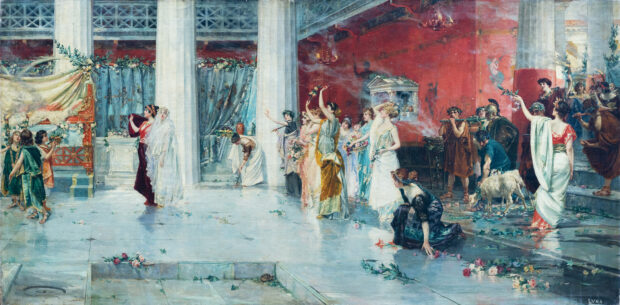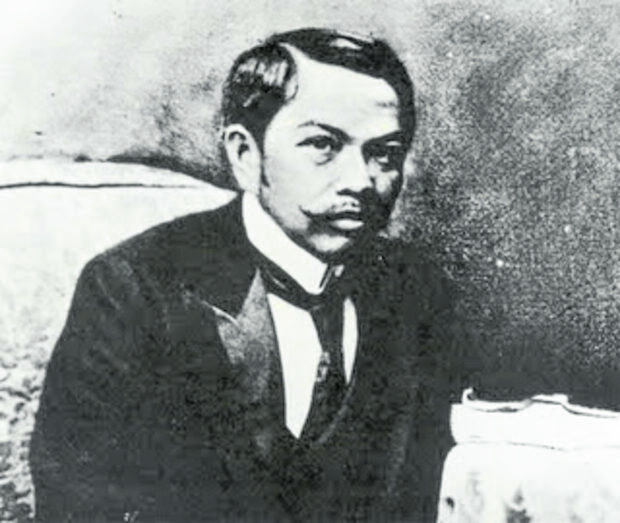Long-lost Luna ‘greatest PH art find in history’

THE GLORY THAT IS LUNA | Juan Luna’s “Hymen, oh Hyménée!” went missing for more than half a century after the artist’s death in 1899, until it was found in the collection of an “aristocratic family” in Europe who later agreed to sell it to León Gallery owner Jaime Ponce de Leon. For art lovers and scholars, the country’s 125th Independence Day celebration is made more momentous by its exhibition at Ayala Museum in Makati City on Monday. (Image courtesy of the Ayala Museum)
MANILA, Philippines — It is 1886 and Juan Luna is at a high. Two years earlier, his large oil painting “Spoliarium” had won the gold medal at the Exposición Nacional de Bellas Artes in Madrid.
More importantly, Luna had married Paz Pardo de Tavera on Dec. 8. Overjoyed, he began working on a series of paintings on his honeymoon as he traveled from Rome to Venice.
The most important work to emerge from that series, most likely finished in 1887, was “Hymen, oh Hyménée!”
This became one of Luna’s favorite paintings. He displayed it prominently in his Paris studio. He considered this painting a prized personal possession not meant for public viewing.
In 1889, on the occasion of the 100th anniversary of the French Revolution, Paris hosted the Exposition Universelle. So important was this international event that this was when the iconic Eiffel Tower was inaugurated.
Article continues after this advertisementDue to a clamor by the media, Luna was allowed to display his works as part of the Spanish exhibit. But because of a variety of reasons, he could not actually display the paintings he wanted to exhibit. Instead, he submitted “Hymen, oh Hyménée!”
Article continues after this advertisementThe work awed viewers and it won the bronze medal — then and now the single greatest award ever accorded to a painting by a Filipino.
The painting was in Luna’s possession until 1899 when he died of cardiac arrest in Hong Kong. Then it vanished.

Juan Luna (1857 to 1899)
‘Holy grail’
There are many theories about what happened to it. One theory has the Pardo de Tavera family burning it after Luna killed his wife in 1892 out of jealousy. Another had it destroyed during one of the wars. Yet another had it being sold to a French museum.
Despite a frenzied search, it could not be found, and “Hymen, oh Hyménée!” became known as the “holy grail of Philippine art.”
Many people considered it lost or destroyed, and we only know what it looks like through surviving lithographs. Yet these do not measure up, as the lithographs are monochromatic and the painting is in color.
Then, some 50 years ago, prolific Filipino collector Dr. Eleuterio “Teyet” Pascual was invited to view the art collection of “an aristocratic family in Europe,” as the family was merely described to him.
That was when Pascual saw the painting. It had survived.
Apparently, the painting had been bought by the family in the 1920s. Pascual did everything he could to buy it, but the painting was not for sale.
Twenty years later, another collector got a glimpse of the painting but, like Pascual, failed to land it.
‘Priceless’
In 2014, León Gallery owner Jaime Ponce de Leon found himself stunned, as he stood where the two others had before him, staring at “Hymen, oh Hyménée!”
He, too, had futilely followed the clues in search of the painting. He had heard of the previous sightings but had no idea he had been invited to see the “grail,” as he called it.
And this time, the family was ready to sell.
The painting would be the single most expensive piece of art Ponce de Leon ever bought for his collection. It would take three years to complete the purchase, as this required connoisseurship and provenance to authenticate.
But in the end, it was in private Filipino hands.
He said he would not even venture a guess as to its monetary value. “It is priceless,” he told the Inquirer. He has no plans to sell it.
Historian Ambeth Ocampo was among those who helped authenticate the painting.
“It was a welcome surprise as a Luna scholar to come face to face with a painting unlocated in over a century. The condition is pristine, except for a … discolored varnish that should be removed with expert restoration and conservation to bring out its vivid colors. It has all of the signs of authentic Lunas I always look for,” Ocampo said.
‘Olympics of art’
Ponce de Leon did not tell anyone right away about the painting. It was hidden away in a wooden crate until October 2022, when he met with the Ayala Foundation on fundraising ideas. When he told them what he had, “they were floored,” he said.
After seven months of planning, Ayala Museum’s new exhibition, “Splendor: Juan Luna, Painter as Hero,” will open to the general public on June 12, the country’s 125th Independence Day. For that day, entrance to the museum is free.
“The painting takes its name from a traditional ancient marital chant referring to the Greek god, Hymen, who is the god of marriage,” explained Marinella Mina, one of the exhibition’s curators.
“What you will find is the tail end of the marriage procession. I think something quite unknown to many people today is that a lot of our wedding traditions in the Roman Catholic Church actually follow from ancient Roman wedding rituals. So these are some of the things that you find actually, within the painting,” she said.
Ponce de Leon noted that while most Filipinos consider the much larger “Spoliarium” (at a massive 4 by 7 meters) to be Luna’s masterpiece, it is actually “Hymen, oh Hyménée!” — measuring a comparatively smaller 125 by 250.5 centimeters — which received the greater honor.
He said “Paris was the ground zero of art. Luna also won an award, but that was in Madrid, and Madrid was the—you would call it provincial, or you know in simpler terms—Palarong Pambansa. And this painting won in Paris, which was like … the Olympics of art. So this put him in the pantheon of the greatest artists of the world.”
Rizal likely among admirers
Luna’s victory resonated among Filipinos. Ocampo, who wrote essays for the exhibition catalog and also narrated the video tour of the painting for the Ayala Museum website, explained that it “produced a groundswell of pride in [his] countrymen that resonates to our times with Lea Salonga’s triumph on the West End and Broadway, Manny Pacquiao’s conquest of World Boxing and, last but not the least, weightlifter Hidilyn Diaz bringing home the first Olympic Gold to a proud and grateful nation.”
Not only that, but it was very likely that national hero José Rizal saw this painting. He belonged to the same group of expats in Europe as Luna; he often visited Luna’s Paris studio.
Ocampo explained that he owns the actual 19th-century photograph of Luna’s studio, taken by Felix Resurreccion Hidalgo, and you can see the painting itself behind a sofa.
Ponce de Leon said “It is impossible for us not to assume that Luna showed this scene, this painting to Rizal.”
He described the recovery of “Hymen, oh Hyménée!” as the “greatest art discovery in Philippine history.”
“Hymen, oh Hyménée!” will be on loan to the Ayala Museum as the centerpiece of the “Splendor: Juan Luna, Painter as Hero” exhibition until Dec. 31.